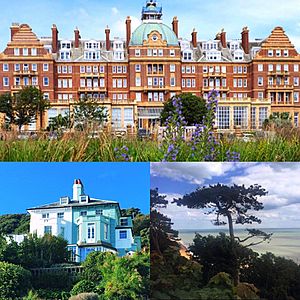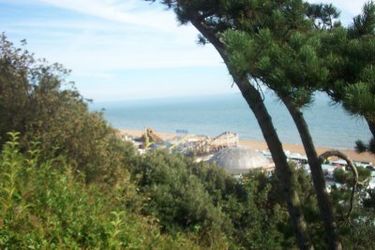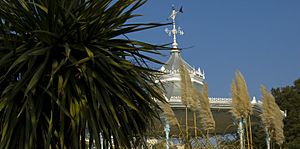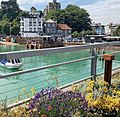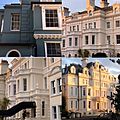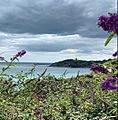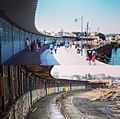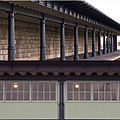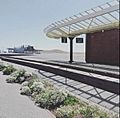Folkestone facts for kids
Quick facts for kids Folkestone |
|
|---|---|
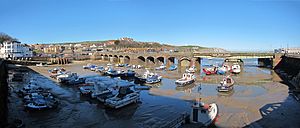 |
|
| Population | 46,698 (2011) |
| OS grid reference | TR218361 |
| • London | 71.3 mi (114.7 km) |
| District |
|
| Shire county | |
| Region | |
| Country | England |
| Sovereign state | United Kingdom |
| Post town | FOLKESTONE |
| Postcode district | CT18–CT20 |
| Dialling code | 01303 |
| Police | Kent |
| Fire | Kent |
| Ambulance | South East Coast |
| EU Parliament | South East England |
| UK Parliament |
|
Folkestone ( FOHK-stən) is a port town on the English Channel, in Kent, south-east England. The town lies on the southern edge of the North Downs at a valley between two cliffs. It was an important harbour and shipping port for most of the 19th and 20th centuries.
There has been a settlement in this location since the Mesolithic era. A nunnery was founded by Eanswith, granddaughter of Æthelberht of Kent in the 7th century, who is still commemorated as part of the town's culture. During the 13th century it subsequently developed into a seaport and the harbour developed during the early 19th century to provide defence against a French invasion, and expanded further West after the arrival of the railway in 1843 as an elegant coastal resort thanks to the investment of the Earl of Radnor under the urban plan of Decimus Burton.
In its heyday - during the Edwardian Era - Folkestone was considered the most fashionable resort of the time, visited by Royalties - amongst them Queen Victoria and Edward VII and other members of the English Aristocracy. The architecture of the town, especially in the West End part of the town is a testimony of this period with many impressive buildings, townhouses, villas, private squares and large hotels built to accommodate the gentry. Unfortunately after two world wars and the boom of the holiday package abroad, the town quickly declined. The harbour's use has diminished since the opening of the nearby Channel Tunnel and stopping of local ferry services, but still remains in active use. Folkestone is the English terminus of the Channel Tunnel.
Contents
History
The area of Folkestone has been occupied since at least the Mesolithic era. In 2010, worked flints were discovered below the remains of the Folkestone Roman Villa. The East Cliff area was excavated in 1924 and most recently from 2010 - 2011, which has produced artifacts from the Mesolithic period through to the Roman Era. On the East Cliff, an extensive Iron Age oppidum existed, which produced quern-stones on an almost industrial scale. These querns, or stones used for grinding cereals into flour, were traded for continental exports such as pottery and wine. A modest Roman style villa was constructed over the Iron Age settlement sometime during the first century AD, followed by a more luxurious one in about 200 AD. The villa was abandoned sometime during the third or fourth century for unknown reasons.
In 597 AD, monks led by St Augustine arrived at Ebbsfleet on the Isle of Thanet, on a mission from Pope Gregory to re-Christianise Britain. He was greeted by the Anglo Saxon pagan King of Kent, Ethelbert and his Christian Queen, Bertha. Augustine was granted land in Canterbury where he built his church and outside the walls founded the monastery of St Peter & St Paul - now known as St Augustine's. Ethelbert was succeeded as Anglo-Saxon king of Kent by his son Eadbald, whose daughter Eanswythe refused all offers of marriage. In 630 AD, Eanswythe founded a nunnery on the site of her father's castle near Folkestone by the present parish Church of St Mary & St Eanswythe.
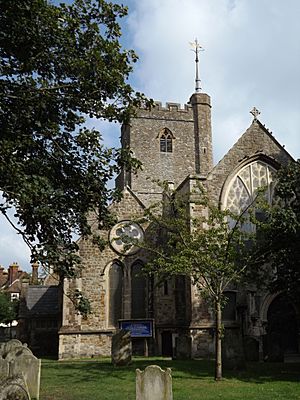
Eanswythe died c 640 AD and was quickly made a saint. Her remains were moved into the chancel of the current church in the 12th century. They became the focus of prayer and pilgrimage such that Eanswythe was quickly adopted as the town's patron. The community grew and developed into a monastery until it was dissolved by Henry VIII, and St Eanswythe's remains disappeared. They were rediscovered in June 1885 when workmen, carrying out alterations to the high altar, found a battered lead casket immured in a niche in the north wall of the chancel. Examination by archaeologists at the time and again in 1981 confirmed that the casket was of Anglo-Saxon origin and the few bone fragments were those of a woman in her early 30s. These relics are still housed in the church close to where they were discovered in the north wall of the chancel flanked by a pair of small brass candlesticks. St Eanswythe is celebrated on 12 September each year - the date on which her relics were moved to the present chancel. She also appears on the town's seal with William Harvey, the Folkestone-born,17th-century physician who discovered the circulation of the blood.
A Norman knight held a Barony of Folkestone, which led to its entry as a part of the Cinque Ports in the thirteenth century and with that the privilege of being a wealthy trading port. At the start of the Tudor period it had become a town in its own right. Wars with France meant that defences had to be built here and soon plans for a Folkestone Harbour began. At the beginning of the 1800s a harbour was developed, but it was the coming of the railways in 1843 that would have the bigger impact.
Dover Hill, which is the highest point in Folkestone, was a sighting point for the Anglo-French Survey (1784–1790), which measured the precise distance between the Royal Greenwich Observatory and the Paris Observatory. The hill provided a sight-line to the east along the line of the Folkestone Turnpike to Dover Castle, one of the two principal cross-channel observation points, the other being Fairlight Down in Sussex.
Folkestone Harbour
Until the 19th century Folkestone remained a small fishing community with a seafront that was continually battered by storms and encroaching shingle that made it hard to land boats. In 1807 an Act of Parliament was passed to build a pier and harbour which was built by Thomas Telford in 1809. By 1820 a harbour area of 14 acres (5.7 hectares) had been enclosed. Folkestone's trade and population grew slightly but development was still hampered by sand and silt from the Pent Stream. The Folkestone Harbour Company invested heavily in removing the silt but with little success. In 1842 the company became bankrupt and the Government put the derelict harbour up for sale. It was bought by the South Eastern Railway Company (SER), which was then building the London to Dover railway line. George Turnbull was responsible in 1844 for building the Horn pier. Dredging the harbour, and the construction of a rail route down to it, began almost immediately, and the town soon became the SER’s principal packet station for the Continental traffic to Boulogne.
Folkestone Harbour Company commissioned Foster Associates to produce a masterplan for Folkestone which was published in April 2006. The plans describe the rebuilding of the harbour as a marina, a "Green Wave" along the sea front linking countryside west and east of the town, new housing, shops, a performance area and small university campus. The plans take in the land that was previously the Rotunda Amusement Park. Progress in developing the area has been inhibited by the recession and by new guidelines governing flood protection. A new approach to the seafront is being developed by Terry Farrell and Partners, and the former fairground site is being considered for temporary recreational use whilst planning takes place.
However, there is an alternative plan being developed by the Remembrance Line Association which is based on retaining the harbour railway and its station as a major heritage/tourist operation and 'Leaving for War' museum given the significance of the Folkestone Harbour Branch in both world wars which is important to the Allied and Commonwealth nations. The harbour railway station, now unused, is gradually succumbing to nature.
Toponymy
Although Kent was the first part of the British mainland to be conquered and settled by the invading Angles, Saxons and Jutes from the middle of the 5th century AD onwards, after the departure of the Romans, it was not until the late 7th century that the spelling Folcanstan appears. One suggestion is that this refers to Folca's stone; another suggestion is that it came from an Old English personal name, with the addition of stone, possibly meaning, in this context, "meeting place". It was not until the mid 19th century that the spelling of "Folkestone" was fixed as such, with the Earl of Radnor requesting that the town's name be standardised (although this tendency towards standardisation in the 19th century is true of English place names generally). Folkestone is often misspelt, variants including Folkston, Folkstone & Folkeston.
Geography
Folkestone is located where the southern edge of the North Downs, escarpment meets the sea. In contrast to the white cliffs at Dover further to the east, the cliffs at Folkestone are composed of Greensand and Gault Clay. A small stream, Pent Brook, cuts through the cliffs at this point, and provided the original haven for fishermen and cross-channel boats. The cliffs are constantly under attack from the sea: the original headlands, which once protected the port, ceased to do so, and artificial protection, in the form of breakwaters and piers have been necessary since the 17th century.
The town is now built on both sides of the original valley: the West Cliff and The Bayle to the West, and the East Cliff on the other side of the stream. The Pent Stream now runs through a culvert from the fire station, at the junction of Radnor Park Road, Park Farm and Pavilion Road, until it reaches the inner harbour. Remains of a quay, dating to the 17th century, were discovered under what is now a public car park, between the Old High Street and the railway viaduct, adjacent to the current harbour. Included in the town is Cheriton, where the Channel Tunnel northern exit is located; Newington; and Peene.
In August 1996 a one in 600 years storm left homes and businesses in Black Bull Road, in the Foord Valley, under two metres of water. Heavy rainfall combined with inadequacies in the Pent Stream and local drainage to cause the flooding. A crowd of 2,332 saw Folkestone Invicta play hosts to West Ham United in a benefit game following the flood.
Climate
| Jan | Feb | Mar | Apr | May | Jun | Jul | Aug | Sep | Oct | Nov | Dec | Year |
|---|---|---|---|---|---|---|---|---|---|---|---|---|
| 8.0 °C (46.4 °F) | 8.0 °C (46.4 °F) | 7.5 °C (45.5 °F) | 9.3 °C (48.7 °F) | 11.6 °C (52.9 °F) | 14.1 °C (57.4 °F) | 16.0 °C (60.8 °F) | 17.6 °C (63.7 °F) | 17.7 °C (63.9 °F) | 16.2 °C (61.2 °F) | 14.2 °C (57.6 °F) | 11.1 °C (52.0 °F) | 12.6 °C (54.7 °F) |
Landmarks
The major landmark in Folkestone, apart from the harbour, is the Leas, the cliffs above the beach. A Martello Tower (No 3) stands on the cliff above Copt Point. Built in 1806 as a defence against Napoleon, it has also been a Coast Guard lookout, a family home, a golf clubhouse and a Second World War Naval mine control post. It now houses a visitor centre. The Folkestone White Horse is carved on Cheriton Hill above the Channel Tunnel terminal.
The Kent Downs Area of Outstanding Natural Beauty includes part of the town area. The nearby Brockhill Country Park, to the west, with footpaths around a lake and in a valley, links with the Royal Military Canal at Hythe.
Folkestone is near to two important Battle of Britain landmarks – the Battle of Britain Memorial, Capel-le-Ferne and the Kent Battle of Britain Museum – the oldest Battle of Britain Museum in the UK.
Transport
Folkestone developed because of its transport links. With France visible across the Strait of Dover, the town became an important transit point for those travelling from the UK to the Continent. Talks about restoring the ferry traffic to Boulogne since it was terminated in 2000 were held in 2005, but this has not been resolved; and the Channel Tunnel northern entrance is located at Cheriton.
Rail
The railway reached Folkestone on 28 June 1843 and a temporary railway station was built while the construction of the line to Dover continued. This started with the Foord viaduct, designed by Sir William Cubitt, completed in 1844. Folkestone Junction railway station was then opened and construction through the cliffs between Dover and Folkestone commenced. Once the line was opened to Dover, the town began to prosper (which meant growth westwards), further stations were opened at Folkestone West (originally named Shorncliffe Camp) in 1863, and Folkestone Central in 1884. Folkestone Harbour station was used to trans-ship whole trains; the line from the junction was very steep and needed much additional locomotive help. A local group, the Remembrance Line Association, is actively seeking to retain the harbour branch as a tourist/heritage railway operation. Today the domestic services from Folkestone use the Central and West stations on the South Eastern Main Line. Venice-Simplon Orient Express passengers now change at Folkestone West for road coaches and the onward journey through the Channel Tunnel.
High Speed 1 (HS1) is a high speed railway built to French 'LGV' (Ligne à Grande Vitesse) standards, connecting the Channel Tunnel to London. Since December 2009, high speed commuter services from Dover have called at Folkestone and then, using the South Eastern Main Line to Ashford International, the services join HS1 for the journey to Ebbsfleet, Stratford International and London St Pancras. The journey time to London via this route has been reduced to under 1 hour; some trains from Folkestone West take as little as 52 minutes to reach the capital by High Speed Train.
The Eurotunnel Shuttle terminal, for car transport to Calais by train using the Channel Tunnel, is in the Folkestone suburb of Cheriton.
The Leas Lift, a Victorian water lift that opened in 1885, connects the Leas with the beach.
There were two other lifts on the Leas in Folkestone history: the Metropole Lift (closed in 1940) and the Sandgate Hill Lift, which closed in 1918.
Roads
The town is located at the eastern end of the M20 which provides fast access to Ashford, Maidstone, London and also to the M25. The A20 is motorway-standard to Dover and runs locally towards Ashford and London, following the M20 but runs locally via Sellindge, Ashford, Lenham, Maidstone, Aylesford, Wrotham and Swanley where the A20, M20 and M25 meet and the A20 continues through Sidcup and Lewisham to Central London. Folkestone marks the eastern end of the A259 although this is no longer part of the South Coast Trunk Road east of Brenzett, although it remains a primary route. The road gives access to the Romney Marsh, Hastings, Eastbourne and beyond. To the north, roads connect Folkestone to Canterbury and the nearby villages of Elham and Lyminge.
Stagecoach in East Kent operates local buses from the town. It is served by The Link services to Canterbury, The Wave service to Dover, Romney Marsh and Hastings. Other bus routes run to Hythe, Ashford and Maidstone.
National Express runs coaches to Ashford, Dover, Hythe, Maidstone and London.
Leisure
The town is situated at the foot of the North Downs, with views of the surrounding countryside and the coast of France, a mere 24 miles (39 km) away. The area is a magnet for passing migrating birds and the Warren (woodlands adjoining Wear Bay) and the cliffs above are of particular interest during the spring and autumn periods. These are now part of East Cliff and Warren Country Park.
Folkestone Parks and Pleasure Grounds Charities are lands which were donated to the people of Folkestone for perpetual recreational use by the Earls of Radnor during the 19th century. The lands are administered by Shepway District Council, with the Cabinet members forming the Board of Trustees. Previously, the Charter Trustees were also Trustees of the Charities, but that arrangement lapsed upon the parishing of the Folkestone and Sandgate area. Negotiations are ongoing regarding the transfer of the lands to Folkestone Town Council and Sandgate Parish Council.
There are two major long distance footpaths through the town. The North Downs Way, starting its course in Surrey, reaches the coast at Folkestone and continues through Capel-le-Ferne, and to its end at Dover, some 8 miles (13 km) away. The Saxon Shore Way starts at Gravesend, Kent and traces the Kent coast as it was in Roman times, via Folkestone, as far as Hastings, East Sussex, 163 miles (262 km) in total.
Nearby places of interest include the Kent Battle of Britain Museum and the Battle of Britain Memorial, Capel-le-Ferne
Culture
Folkestone has been home to many galleries over the years. The long-established Metropole Galleries, located in the one-time Metropole Hotel on the Leas, staged year round exhibitions until it closed in 2008. Its place has been largely taken by the Creative Foundation. The Foundation has opened a medium scale theatre, conference and music venue in the heart of the Creative Quarter named Quarterhouse. It offers a year-round programme of live music, comedy, film, talks, theatre and children's entertainment. George's House Gallery and Googie's Art Cafe hold frequent exhibitions by local artists and the Folkestone Art Society, established in 1928, holds three annual art exhibitions and publishes an annual art review of work by local artists. Leas Cliff Hall is the biggest entertainment and function venue in Folkestone with a large choice of concerts, comedy and theatre.
The first Folkestone Triennial art event took place between June and September 2008 with artists such as Christian Boltanski and Tracey Emin making site specific work for a wide variety of locations around the town. Many of the commissioned works remain permanently in the town. The 2011 Triennial 'A Million Miles From Home' was launched on 24 September 2010 and commissioned 19 international artists to develop new works for Folkestone’s streets, squares, beaches and historic buildings to create a cutting-edge contemporary art exhibition in the public domain.
Folkestone has an annual Chamber Music Festival each May curated by the Sacconi Quartet. The festival is based in the town's 13th century Parish Church of St Mary and St Eanswythe in the Bayle and comprises concerts of chamber and ensemble music with guest performers. The church also hosts a series of Sunday afternoon concerts under the auspices of Bayle Music presenting local, national and international performers as well as occasional concerts by visiting choirs and ensembles.
Folkestone, together with Hythe, has an amateur theatre group: Folkestone & Hythe Operatic & Dramatic Society. It is a charitable organisation, producing and performing several different shows a year at its own venue, the Tower Theatre, located in Shorncliffe. The society also has a youth section, which puts on three performances a year at the Tower Theatre: the Brigadier Thomas Memorial Competition, a summer show and a Christmas revue.
The literary journal The Frogmore Papers, published by the Frogmore Press, was founded in Folkestone in 1983. The Folkestone Book Festival takes place every November.
Folkestone Museum has been transformed into a local history centre: the Folkestone People’s History Centre.
Folkestone has an annual Comic Convention each May organised by Planet Folkestone. The convention is a volunteer run event which raising funds for local charities including Academy FM, East Kent Hospitals and Help for Heroes. Each year more than 7,000 people attend the event, which brings celebrities from TV and film to the coastal town. Folkestone Film, TV and Comic Con 2016 had many actors attending including the television actors Sylvester McCoy and Peter Davison from Dr Who and Julian Glover from Game of Thrones. The 2017 event is set to take place at the iconic Leas Cliff Hall.
An annual Zombie Walk also takes place in Folkestone around Halloween with permission from Shepway District Council. The walk is a fun and safe way for adults and children to celebrate Halloween and has a larger and larger following every year. In 2016, in the events 6th year, the organisers "Planet Folkestone" announced that they were stepping down from organizing the free event as they could no longer commit their own time and resources to the event due to its ever-increasing costs and restrictions.
Twin towns
Folkestone is twinned with:
 Boulogne-sur-Mer, France
Boulogne-sur-Mer, France Middelburg, Netherlands
Middelburg, Netherlands Étaples-sur-Mer, France
Étaples-sur-Mer, France Tres de Febrero, Argentina
Tres de Febrero, Argentina
H.P. White, (1961) A regional history of the railways of Great Britain, II Southern England, London: Phoenix House.
Economy
Folkestone was at one stage a resort town with a developed shipping trade. With the decline of such industries others have filled the gap. The Dormobile works, car conversion manufacturers were based in the town. Church and Dwight, the US company famous for such brands as Arm & Hammer, has its UK headquarters in the town. Silver Spring Mineral Water Company Limited, until recently the largest independently owned soft drinks manufacturer in Britain, was based in Park Farm but closed down in 2013.
During the 1980s and 1990s the construction of the Channel Tunnel provided employment, as well as bringing many people to the area, and on completion the running of service still provides work for many.
Several insurance firms are based in Folkestone. Some of them used to be involved in the shipping trade but have since diversified into other fields. Saga has its headquarters in Folkestone.
Along with other Kent seaside towns, there has been a resurgence in domestic tourism linked to a growing arts scene.
Sport
Folkestone Invicta Football Club was formed in 1936 and played in the Eastern Section of the Kent Amateur League (now the Kent County League), taking over the Cheriton Road ground in early 1991 after the demise of the old Folkestone F.C. which had had a long history in the Southern League.
Folkestone Rugby Club was formed in 1974 and currently play in London and SE league 4. The club runs 4 Adult, a ladies, and various colts teams. A former ladies player, Catherine Spencer, captained the England women's national rugby union team to a grand slam in 2008.
Folkestone Cricket Club currently competes in the first division of the Kent Cricket League. It was formed in 1851. Current Kent players such as Robbie Joseph and Geraint Jones plus Neil Dexter, who moved to Middlesex CCC at the end of the 2008 season, have all represented the club. James Tredwell, who came through the youth academy, is still heavily involved with the club.
Folkestone is home to one of the most prominent Motorcycle Grasstrack clubs – Astra. Their meetings take place at Swingfield Minnis and over the years have hosted a number of championship meetings. In 2007 and 2016 they hosted the European Grasstrack Championship finals and well as the Team Long Track World Championship Team Cup in 2013. They have hosted the major Domestic championship – the British Masters – in 2000, 2008, 2010, 2011 and 2014.
Folkestone Optimist Hockey Club are based at Three Hills Sports Park (along with the cricket and netball clubs).
There is a Bowls Club and a Running Club based in the town.
Folkestone hosted the 5th Chess Olympiad in 1933. Among others, the artist Marcel Duchamp took part as a member of the French team.
Education
Schools and colleges in Folkestone include Folkestone Academy (formed by the merger of Hillside School for Boys and Holywell School for Girls in the early 1970s, and formerly known as Wyndgate Secondary School in the 1970s, the Channel High School in the 1980s, and the Channel School in the 1990s); and Turner Free School (opened in 2018 on the site of Pent Valley Technology College, formerly Pent Valley Secondary Modern, formed by the merger of Harcourt Secondary School for Girls and Morehall Secondary School for Boys in the 1970s).
There are two selective state secondary schools – Folkestone School for Girls (formed by the merger of Folkestone Technical High School for Girls and Folkestone Grammar School for Girls in the 1980s) and the Harvey Grammar School for boys; the latter was founded in 1674. These two schools have a common sixth form timetable.
East Kent College have a Folkestone campus providing a variety of courses including Apprenticeships, Hairdressing and Construction.
From 2007 to 2013 the University Centre Folkestone (a joint initiative of Canterbury Christ Church University and University of Greenwich) was located in the town providing a specialism in Performing Arts.
There are a number of primary schools, both state and independent, in the town. State primaries include Folkestone Primary, Sandgate Primary, Morehall Academy and Martello Grove Academy, a new academy that opened in September 2015. Martello Grove Academy moved to brand new buildings on its campus in Warren Way in the fall 2016.
Images for kids
See also
 In Spanish: Folkestone para niños
In Spanish: Folkestone para niños



